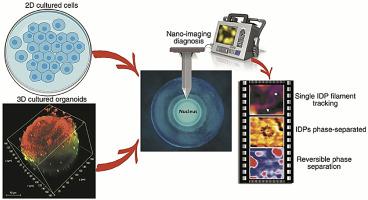Biomaterials ( IF 12.8 ) Pub Date : 2020-06-23 , DOI: 10.1016/j.biomaterials.2020.120198 Mahmoud Shaaban Mohamed 1 , Masaharu Hazawa 2 , Akiko Kobayashi 2 , Laurent Guillaud 3 , Takahiro Watanabe-Nakayama 4 , Mizuho Nakayama 5 , Hanbo Wang 2 , Noriyuki Kodera 4 , Masanobu Oshima 5 , Toshio Ando 4 , Richard W Wong 6

|
Nuclear pore complex (NPC) is a gating nanomachine with a central selective barrier composed mainly of Nups, which contain intrinsically disordered (non-structured) regions (IDRs) with phenylalanine-glycine (FG) motifs (FG-NUPs). The NPC central FG network dynamics is poorly understood, as FG-NUPs liquid-liquid phase separation (LLPS) have evaded structural characterization. Moreover, the working mechanism of single FG-NUP-biofilaments residing at the central lumen is unknown. In general, flexible biofilaments are expected to be tangled and knotted during their motion and interaction. However, filament knotting visualization in real-time and space has yet to be visualized at the nanoscale. Here, we report a spatiotemporally tracking method for FG-NUP organization with nanoscale resolution, unveiling FG-NUP conformation in NPCs of colorectal cells and organoids at timescales of ~150 ms using high-speed atomic force microscopy (HS-AFM). Tracking of FG-NUP single filaments revealed that single filaments have a heterogeneous thickness in normal and cancer models which in turn affected the filament rotation and motion. Notably, FG-NUPs are overexpressed in various cancers. Using the FG-NUP inhibitor, trans-1,2-cyclohexanediol, we found that central plug size was significantly reduced and incompletely reversible back to filamentous structures in aggressive colon cancer cells and organoids. These data showed a model of FG-NUPs reversible self-assembly devolving into the central plug partial biogenesis. Taken together, HS-AFM enabled the tracking and manipulation of single filaments of native FG-NUPs which has remained evasive for decades.
中文翻译:

时空跟踪核孔复合体核心内的纳米生物丝。
核孔复合物(NPC)是具有主要由Nups组成的中央选择性屏障的门控纳米机器,它包含具有苯丙氨酸-甘氨酸(FG)基序(FG-NUPs)的内在无序(非结构化)区域(IDR)。人们对NPC中央FG网络的动力学知之甚少,因为FG-NUP的液相-液相分离(LLPS)规避了结构表征。此外,单个FG-NUP-生物丝驻留在中央管腔的工作机制是未知的。通常,柔性生物丝在其运动和相互作用期间会被缠结和打结。然而,实时和空间的细丝打结可视化还没有在纳米级上可视化。在这里,我们报告了具有纳米级分辨率的FG-NUP组织的时空跟踪方法,使用高速原子力显微镜(HS-AFM)在约150 ms的时标上揭示了结直肠细胞和类器官NPC中的FG-NUP构象。跟踪FG-NUP单丝显示,在正常模型和癌症模型中,单丝的厚度不均匀,这反过来又影响了丝的旋转和运动。值得注意的是,FG-NUPs在各种癌症中过表达。使用FG-NUP抑制剂,反式-1,2-环己二醇,我们发现在侵略性结肠癌细胞和类器官中,中央栓塞的大小显着减小,并且不完全可逆转回丝状结构。这些数据显示了FG-NUPs可逆自组装模型发展成为中央栓塞部分生物发生。综上所述,HS-AFM能够跟踪和操纵天然FG-NUP的单丝,这种单丝一直在逃避数十年。











































 京公网安备 11010802027423号
京公网安备 11010802027423号